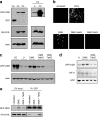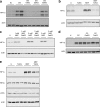Cell-permeating alpha-ketoglutarate derivatives alleviate pseudohypoxia in succinate dehydrogenase-deficient cells
- PMID: 17325041
- PMCID: PMC1899954
- DOI: 10.1128/MCB.01927-06
Cell-permeating alpha-ketoglutarate derivatives alleviate pseudohypoxia in succinate dehydrogenase-deficient cells
Abstract
Succinate dehydrogenase (SDH) and fumarate hydratase (FH) are components of the tricarboxylic acid (TCA) cycle and tumor suppressors. Loss of SDH or FH induces pseudohypoxia, a major tumor-supporting event, which is the activation of hypoxia-inducible factor (HIF) under normoxia. In SDH- or FH-deficient cells, HIF activation is due to HIF1alpha stabilization by succinate or fumarate, respectively, either of which, when in excess, inhibits HIFalpha prolyl hydroxylase (PHD). To reactivate PHD, we focused on its substrate, alpha-ketoglutarate. We designed and synthesized cell-permeating alpha-ketoglutarate derivatives, which build up rapidly and preferentially in cells with a dysfunctional TCA cycle. This study shows that succinate- or fumarate-mediated inhibition of PHD is competitive and is reversed by pharmacologically elevating intracellular alpha-ketoglutarate. Introduction of alpha-ketoglutarate derivatives restores normal PHD activity and HIF1alpha levels to SDH-suppressed cells, indicating new therapy possibilities for the cancers associated with TCA cycle dysfunction.
Figures





Similar articles
-
Inhibition of α-KG-dependent histone and DNA demethylases by fumarate and succinate that are accumulated in mutations of FH and SDH tumor suppressors.Genes Dev. 2012 Jun 15;26(12):1326-38. doi: 10.1101/gad.191056.112. Epub 2012 Jun 7. Genes Dev. 2012. PMID: 22677546 Free PMC article.
-
Intermediary metabolite precursor dimethyl-2-ketoglutarate stabilizes hypoxia-inducible factor-1α by inhibiting prolyl-4-hydroxylase PHD2.PLoS One. 2014 Nov 24;9(11):e113865. doi: 10.1371/journal.pone.0113865. eCollection 2014. PLoS One. 2014. PMID: 25420025 Free PMC article.
-
Redox stress is not essential for the pseudo-hypoxic phenotype of succinate dehydrogenase deficient cells.Biochim Biophys Acta. 2006 May-Jun;1757(5-6):567-72. doi: 10.1016/j.bbabio.2006.05.015. Epub 2006 May 17. Biochim Biophys Acta. 2006. PMID: 16797480
-
Succinate dehydrogenase and fumarate hydratase: linking mitochondrial dysfunction and cancer.Oncogene. 2006 Aug 7;25(34):4675-82. doi: 10.1038/sj.onc.1209594. Oncogene. 2006. PMID: 16892081 Review.
-
The connection between tricarboxylic acid cycle enzyme mutations and pseudohypoxic signaling in pheochromocytoma and paraganglioma.Front Endocrinol (Lausanne). 2023 Oct 5;14:1274239. doi: 10.3389/fendo.2023.1274239. eCollection 2023. Front Endocrinol (Lausanne). 2023. PMID: 37867526 Free PMC article. Review.
Cited by
-
HIF-independent role of prolyl hydroxylases in the cellular response to amino acids.Oncogene. 2013 Sep 19;32(38):4549-56. doi: 10.1038/onc.2012.465. Epub 2012 Oct 22. Oncogene. 2013. PMID: 23085753 Free PMC article.
-
Hypoxia-inducible factor (HIF) network: insights from mathematical models.Cell Commun Signal. 2013 Jun 10;11(1):42. doi: 10.1186/1478-811X-11-42. Cell Commun Signal. 2013. PMID: 23758895 Free PMC article.
-
Pyruvate dehydrogenase kinase as a novel therapeutic target in oncology.Front Oncol. 2013 Mar 7;3:38. doi: 10.3389/fonc.2013.00038. eCollection 2013. Front Oncol. 2013. PMID: 23471124 Free PMC article.
-
p32 regulates glycometabolism and TCA cycle to inhibit ccRCC progression via copper-induced DLAT lipoylation oligomerization.Int J Biol Sci. 2024 Jan 1;20(2):516-536. doi: 10.7150/ijbs.84399. eCollection 2024. Int J Biol Sci. 2024. PMID: 38169635 Free PMC article.
-
Evaluation of Cysteinyl Leukotriene Signaling as a Therapeutic Target for Colorectal Cancer.Front Cell Dev Biol. 2016 Sep 21;4:103. doi: 10.3389/fcell.2016.00103. eCollection 2016. Front Cell Dev Biol. 2016. PMID: 27709113 Free PMC article. Review.
References
-
- Astrom, K., J. E. Cohen, J. E. Willett-Brozick, C. E. Aston, and B. E. Baysal. 2003. Altitude is a phenotypic modifier in hereditary paraganglioma type 1: evidence for an oxygen-sensing defect. Hum. Genet. 113:228-237. - PubMed
-
- Bensaad, K., A. Tsuruta, M. A. Selak, M. N. Vidal, K. Nakano, R. Bartrons, E. Gottlieb, and K. H. Vousden. 2006. TIGAR, a p53-inducible regulator of glycolysis and apoptosis. Cell 126:107-120. - PubMed
-
- Covello, K. L., and M. C. Simon. 2004. HIFs, hypoxia, and vascular development. Curr. Top. Dev. Biol. 62:37-54. - PubMed
-
- Dahia, P. L. M., K. N. Ross, M. E. Wright, C. Y. Hayashida, S. Santagata, M. Barontini, A. L. Kung, G. Sanso, J. F. Powers, A. S. Tischler, R. Hodin, S. Heitritter, F. J. Moore, R. Dluhy, J. A. Sosa, I. T. Ocal, D. E. Benn, D. J. Marsh, B. G. Robinson, K. Schneider, J. Garber, S. M. Arum, M. Korbonits, A. Grossman, P. Pigny, S. P. A. Toledo, V. Nose, C. Li, and C. D. Stiles. 2005. A HIF1α regulatory loop links hypoxia and mitochondrial signals in pheochromocytomas. PLoS Genet. 1:e8. - PMC - PubMed
Publication types
MeSH terms
Substances
LinkOut - more resources
Full Text Sources
Other Literature Sources
Miscellaneous
